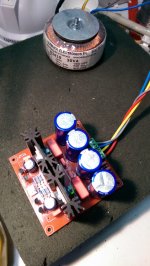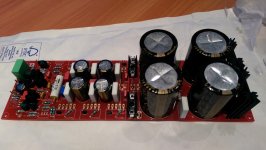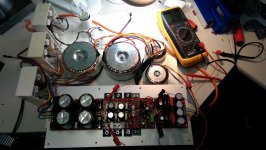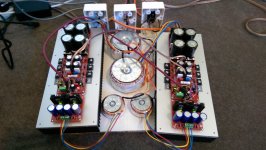Paul, I do it exactly as Andreas does!
I install the speaker-protection, listen to the AMP for a while (some months), and if everything works o.k. so far, I remove the protection module.
Best regards - Rudi
I install the speaker-protection, listen to the AMP for a while (some months), and if everything works o.k. so far, I remove the protection module.
Best regards - Rudi
Paul, I do it exactly as Andreas does!
I install the speaker-protection, listen to the AMP for a while (some months), and if everything works o.k. so far, I remove the protection module.
Best regards - Rudi
Call me a purist or a mad scientist but I've never had such thing in my amp 🙂
This doesn't mean that you should do the same ...
Member
Joined 2009
Paid Member
I always include a speaker protection these days. The modern solid state relay approach based on NMOS with low on-resistance has NO impact on sound quality and a nice impact on my peace of mind.
I always include a speaker protection these days. The modern solid state relay approach based on NMOS with low on-resistance has NO impact on sound quality and a nice impact on my peace of mind.
You have a SS relay in series between amplifier and speaker?
Why not put that relay as crowbar over power lines?
What is the best option for the input DC blocking cap? It should be 3.3 to 3.9uF according to Andrew? I haven't been able to find any quality polypropylene caps that would fit 15mm lead spacing on Rudi's board.
I was trying 4.7uF polypropilene capacitor from Arcotronics in my project and I can get down the THD 1khz at almost 0.0001%. I was changing 4.7uF with 22uF bipolar elcap fromt Fischer & Tausche ATBI serie and the result are ... the same 😉 In the negative feedback again it is a ....bipolar elcap.
I always include a speaker protection these days. The modern solid state relay approach based on NMOS with low on-resistance has NO impact on sound quality and a nice impact on my peace of mind.
Why don't you put the SS relay under the negative feedback ? 🙂
You have a SS relay in series between amplifier and speaker?
Why not put that relay as crowbar over power lines?
Or in place of supply fuses between the elcaps and output transistors.
Member
Joined 2009
Paid Member
Why don't you put the SS relay under the negative feedback ? 🙂
Interesting suggestion, but here's my reasons
a) My first SS relay was on a separate board and you don't want long wires as part of your feedback loop. My 2nd SS relay was on-board (search for my TGM8 amplifier) so I could have done it there
b) Sometimes you want a delayed turn-on which means the SS relay is open and you don't want to break the feedback loop when the power supply / amplifier is just warming up at turn-on
c) Perhaps having the feedback loop open will produce some undesirable things which I didn't think about yet
d) I find there is no impact on sound quality so why do I need to include it inside the feedback loop ?
Rgds
Until you does the real measurements you don't know if the SS relay is transparent. You can put the relay under the NFB for lower distortions and for high damping factor. Of sure, you must to have all time the closed feedback loop. For that u can put a parallel resistor on the relay, 1k ohm for example ?
Can I ask what people have been using for silcone pads? I can get normal or self adhesive ones. Also need to use silcone grease with them?
soft insulators change shape to fill the holes between the device and sink.
hard insulators (or no insulator) need a Thermal Paste to fill the holes between the device and sink.
hard insulators (or no insulator) need a Thermal Paste to fill the holes between the device and sink.
Member
Joined 2009
Paid Member
Until you does the real measurements you don't know if the SS relay is transparent.
I don't have the measurement equipment to do this. But since it's for my personal listening pleasure - if I don't hear a difference between SS relay or a wire then I'm content to have the SS relay in the circuit in series with the speaker.
Perhaps SS relays aren't yet as popular so there isn't very much information about them - but I've never read a report where somebody was unhappy with having a SS relay in their speaker circuit. Until this thread.
soft insulators change shape to fill the holes between the device and sink.
hard insulators (or no insulator) need a Thermal Paste to fill the holes between the device and sink.
Thanks Andrew.
Managed to get first channel up and running ok. Output offest is 2mv. 😀
Attachments
Last edited:
Congratulations, Paul! Go ahead!
Best regards - Rudi
P.S.: Paul: remove the light-bulb, please. There is a small amount of voltage dropping across it, so the transformer's secondaries will not reach their designated value, and re-adjust again!
Best regards - Rudi
P.S.: Paul: remove the light-bulb, please. There is a small amount of voltage dropping across it, so the transformer's secondaries will not reach their designated value, and re-adjust again!
Last edited:
But what should I play for Mihai? Mihai this is a truly exceptional amplifier. Thank you for sharing it with us sir!
I'm glad you like it!
Play Dream Theater - Pull Me Under ... only an exceptional amplifier will reveal all the layers of this song 🙂
You also need to have a very good player and speakers
- Status
- Not open for further replies.
- Home
- Amplifiers
- Solid State
- Roender's FC-100 prototype and builder's thread



